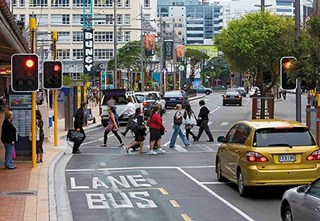
Wellington needs a first principles review of its transport network that is independent and unsullied by politics.
With the local election results out of the way, attention now turns to sorting out our transport network. And judging by the proposals on the table, there is plenty of work to do.
National roading projects are judged (in part) by their benefit cost ratios (BCRs). This basically tells us how much benefit we get from each dollar spent; with a value more than 1 meaning we get more benefit than cost. Of the seven projects that make up Wellington’s road of national significance (RONS) five – the airport to Mt Victoria, the Terrace tunnel, Peka Peka to Otaki, Transmission Gully and MacKays Crossing to Peka Peka – fail that test, with a BCR of less than 1. Only two (the Basin Reserve and the Aotea Quay to Ngauranga upgrade) create more value than they cost.
How did so many of Wellington’s RONS projects end up being of such dubious benefit? Our road investments were once made by an arms-length body known as Transfund, which made its decisions based on where it got the best bang for its buck. But since the last Labour Government changed the rules to allow other, more subjective, criteria to influence the final decision, the quality of the spending has gone to hell in a handbasket. Let’s look at what has happened.
Instead of using the BCR alone, projects are now rated on their “strategic fit” and “effectiveness” – terms that are open-ended and anything but definitive, so ideal for politicians to gerrymander.
[quote align=”right” color=”#999999″]What if the RONS money is better spent on a rail tunnel, how would the light rail option come up then? Of course, given the Government is saying it’s going to bring a magic road carpet all the way from Otaki through to the airport, then that makes road- based adjuncts around the city more competitive.[/quote] As a result of these changes, politicians now have more influence over where the money is spent – for example simply declaring a project to be part of a “road of national significance” means a project gets the thumbs up for “strategic fit”. RONS can be a totally subjective, political judgment call, leading to projects that have far more to do with influencing strategic votes (in marginal seats, say) than with national benefit. The changes to the decision-making process have resulted in us becoming more enthusiastic to invest in road projects of less benefit. This is partly because we are building more roads (so some are of lower scores anyway), but partly because we are actively selecting road projects with lower BCRs.The Government sticks by the Wellington RONS because, as a package, the seven projects have a combined BCR of a squeak over 1 (and that is only if they add in some assumptions about wider economic benefits that will accrue only if the complete package of roads is finished). In the past, such a low return on investment still wouldn’t have made the grade. Figuring why this Government has such a particular affection for tarmac isn’t easy.
Putting the murky politics of this interference to one side for one moment, Greater Wellington Regional Council has been toiling away on its public transport spine study. This study has been working out what the public transport network should look like in the future. In this it has been comparing the costs and benefits of different options for public transport in Wellington; giving buses more priority, dedicated lanes for “rapid transit buses” and even light rail. The bus rapid-transit option won through in the cost-benefit analysis.
This might well be the best approach, but this particular study was predicated on the assumption that the RONS are going ahead. And if the RONS are flawed to start with, as we’re suggesting, there is every reason to believe that conclusions from the spine study are not defensible. Take the example of the second road tunnel through Mt Victoria. This project is going ahead as part of the RONS, despite a return of just 40 cents for every dollar invested. Both the rapid bus transit and bus priority options in the spine study are assessed assuming this new tunnel goes ahead, so the costs of that tunnel aren’t seen as a cost of rapid bus transit because they are picked up by the RONS.
However, in the spine study the light rail option cops the costs for a new rail tunnel and accordingly fails the viability measure.
That is simply not comparing apples with apples, so the analysis is flawed.
What if the RONS money is better spent on a rail tunnel, how would the light rail option come up then? Of course, given the Government is saying it’s going to bring a magic road carpet all the way from Otaki through to the airport, then that makes road- based adjuncts around the city more competitive.
But there is no justification offered as to why these projects have been grouped together in this way. Government could have looked at the motorway north of Wellington and the inner city road/public transport system as two separate projects, or looked at improving both roading and public transport options to Otaki. Asking different questions can give different answers.
Wellington needs a first principles review of its transport network that is independent and unsullied by politics.
These investments are simply too big and too important to stuff up as a result of some transitory politician’s preconceptions and unsubstantiated declarations. Without an independent, apolitical assessment that stands up to professional peer review, such big calls on the public purse will likely deliver poor outcomes.

